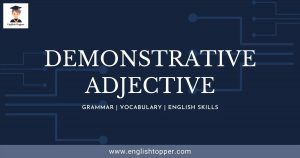|
Getting your Trinity Audio player ready...
|
Table of Contents
What is a Demonstrative Adjective?
A Demonstrative Adjective is used to modify a noun or pronoun to determine its position (near or far along with the time) and how many are there (one or many). It is one of the types of Adjectives.
It is also used to mention its importance in the sentence and it usually appears before the noun and pronoun.
Some of the Demonstrative Adjective examples are this, that, these and those. These are the 4 adjectives that are most commonly used in the sentences.
Let us understand why and when the Demonstrative Adjective is used?
Let’s assume a situation where you are in the museum and looking at the paintings.
Example Sentences:
- The painting is beautiful. (The Sentence without a Demonstrative Adjective)
Here, the people get confused about which painting? – This is where the adjective is used.
So, to mention specific something (with location) we need to use it.
- This painting is beautiful. (The Sentence with a Demonstrative Adjective)
In the above example, we can clearly understand which painting is being referred to.
Also Read: What is Adjective with examples? | Best English Guide 2021
The adjective is a type of word which describes or modifies the noun. It is also defined as, the word which describes the qualities and states of beings of nouns. It measures the qualities like size, shape, colour, duration, behaviour, quantity, and a lot more. It usually provides additional information on noun with the mentioned qualities such as… (Read More)
Types of Demonstrative Adjective
We had previously learned that there are four types of Demonstrative Adjective and two different forms (i.e, Singular and Plural Forms). Let us understand with the below table.
| Forms/locations | Near | Far |
| Singular Form | this | that |
| Plural Form | these | those |
Demonstrative Adjectives based on Place
The adjectives “This” and “That” are used for Singular Form and “These” and “Those” are used for Plural Forms.
Example Sentences: (with common example)
- This (Singular): This building is very beautiful. (near)
- That (Singular): That building is very beautiful. (far)
- These (Plural): These buildings are very beautiful. (near)
- Those (Plural): Those buildings are very beautiful. (far)
More Examples of Demonstrative Adjectives (based on Place)
- That person is very rich.
Sentence Structure: That person (Subject) + is (Verb) + very rich (Object).
The adjective “that” is used to refer to a person (singular) who is a bit far. Here, the subject is a noun.
- I had completed my higher education in this school.
Sentence Structure: I (Subject) + had + completed (Verb) + my higher education in this school (Object).
The adjective “that” is used to refer to the place (singular) that is near. Here, the subject (I) is a pronoun.
- These people are very kind and generous.
Sentence Structure: These people (Subject) + are (Verb) + very kind and generous (Object).
The adjective “these” is used to refer to a group of people (plural) who are near. Here, the subject is a noun.
- Those things are very expensive.
Sentence Structure: Those things (Subject) + are (Verb) + very expensive (Object).
The adjective “those” is used to refer to the things (plural) that are far. Here, the subject (things) is a noun.
Also Read: Noun Definition and Examples | (Best English Guide 2021)
In simple terms, the Noun can be defined as the name of the person, place, thing, animal, idea, emotion, action, event, etc. It can be singular or plural like Cats, Dog, Tables, Chairs, Shoe, etc. Usually, you can call Noun as a naming word, because it… (Read More)
Demonstrative Adjectives based on Place
These adjectives are also used to specify (or describe) time for any events or actions. It can function with the past and present tenses.
| Forms/Tenses | Past | Present |
| Singular Form | that | this |
| Plural Form | those | these |
Example Sentences: (with common example)
- That (Singular): We have to complete this project on that day. (Past)
- Those (Plural): We have to complete this project on those days. (Past)
- This (Singular): We have to complete this project on this day. (Present)
- These (Plural): We have to complete this project on these days. (Present)
Here we can observe that the first two sentences are based on the past tense and the last two sentences are based on the present tense.
More Examples of Demonstrative Adjectives (based on Time)
- Why didn’t you come to the college that day?
Sentence Structure: Why + didn’t + you (Subject) + come (Verb) + to the college that day? (Object)
The adjective “that” is used to describe the past event that happened before. Here, the subject (you) is a pronoun.
- Technology was not that advanced in those days.
Sentence Structure: Technology (Subject) + was (Verb) + not that advanced in those days. (Object)
Here, the adjective “those” is used to describe past events. Here, the subject (Technology) is a noun.
- This day is very important to me.
Sentence Structure: This day (Subject) + is (Verb) + very important to me. (Object)
In the above example, the adjective “this” is used to describe the present event which is happening now. Here, the subject (day) is a noun.
- I was having a lot of work these days.
Sentence Structure: I (Subject) + was having (Verb) + a lot of work these days. (Object)
Here, the adjective “these” is used to describe present events that are happening now and the subject (I) used in the sentence is a pronoun.
Also Read: What are the Tenses in English Grammar? | (with 12 best and easy examples)
A tense is a form of a verb which expresses the time of action in the sentence. It will describe whether the action, had happened in the past (or) is happening in the present (or) will happen in the future… (Read More)
How to (find) identify Demonstrative Adjective in a sentence?
Recently, we had learned that this type of Adjective is used to specify s noun or pronoun. So, it is very easy to find out. Now let us understand the concept with the below example.
- This cookie is very delicious.
Step 1: First, all the structural components such as Subject, Verb and Object.
Sentence Structure: This cookie (Subject) + is (Verb) + very delicious. (Object)
Step 2: Then, consider the Subject part of the sentence and search for any adjectives which are before the noun or pronoun.
We can observe that the noun (cookie) is being described by the adjective (This) which is a Demonstrative Adjective.
- Answer: This.
Also Read: What is a Pronoun? | Pronoun Definition and Examples (2021)
The pronoun is a part of speech which replaces the repeated Noun in the sentence. For example he, she, it, we, they, you, etc. The concept of Pronoun is introduced so that the Noun can be replaced and it has the same function as a Noun… (Read More)
Important Rule for Demonstrative Adjective
Rule 1: The Demonstrative Adjective and the noun should match the form in the sentence.
For Example:
- Incorrect: I don’t like these kind of behaviour. (X)
- Correct: I don’t like this kind of behaviour. (_/) —> (for singular)
- Correct: I don’t like these kinds of behaviour. (_/) —> (for plural)
Summary: (Demonstrative Adjective)

- Demonstrative Adjective is a type of Adjective which is used to specify something by modifying a noun or pronun in a sentence.
- It can be used to describe specific thing based on place or time.
- The most commonly used adjectives are this, that, those and these.
- These four can be used to specify anything based on the past or present events or actions.
- The adjective and the noun/pronoun should be of same type of form (i.e, both should be either Singular or Plural).
If you are interested to learn more, then you can refer to Wikipedia here.
I hope that you understood the topic. If you still have any doubts, then comment down below and we will respond as soon as possible.
Liked this article? Please do share this article with others. Thank you 🙂





